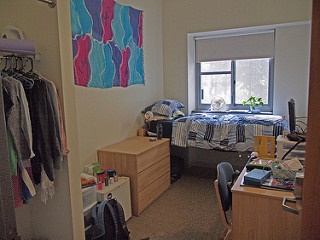According to 2023-2024 data from the Integrated Postsecondary Education Data System (IPEDS), published by the National Center for Education Statistics (NCES), the average cost of on-campus food and housing at a 4-year college was $12,801. For students living off-campus, but not with family, the average food and housing cost was $12,535. On the surface, it appears that to live off of campus is slightly cheaper.
 However, there are several influences that could cause off-campus living to be more expensive. We break down the data below, and cover different factors that could impact your decision on whether it’s cheaper for you to live on or off campus.
However, there are several influences that could cause off-campus living to be more expensive. We break down the data below, and cover different factors that could impact your decision on whether it’s cheaper for you to live on or off campus.
Average Cost of College Housing and Food
Each year, the NCES publishes data on the average costs of college, including food and housing, both on-campus and off.
Here’s a look at the 2023-24 data for full-time, first-time degree/certificate-seeking undergraduates at higher education institutions in the United States and how much they paid on average for food and housing. Off-campus costs are for individuals who were not living with family.
| Type of Institution | Cost for Food and Housing at 4-Year School | Cost of Food and Housing 2-year School |
| Public On-Campus | $12,069 | $8,165 |
| Public Off-Campus | $12,582 | $11,462 |
| Private Nonprofit On-Campus | $12,307 | $10,597 |
| Private Nonprofit Off-Campus | $12,430 | $12,053 |
| Private For-Profit On-Campus | $14,028 | $7,960 |
| Private For-Profit Off-Campus | $12,593 | $12,012 |
Overall, the average cost of living on-campus at a 4-year institution was $12,801 vs. $12,535 when living off-campus, with on-campus housing and food costing just a few hundred dollars more than off-campus.
2-year schools seemingly bucked this trend, with an average of $8,907 on campus and an average of $11,842 off. However, keep in mind that very few 2-year colleges actually have on-campus housing options for students.
It’s important to note that this data only accounts for first-year students. Many 4-year colleges and universities require their incoming class to live in one of their dorms for the first year, unless they’re a non-traditional student or they already live within a certain radius of the school with their family.
7 Factors Influencing Off-Campus Housing Costs
If we took these averages at face value, living on-campus is slightly expensive, but it would likely depend on the college in question. However, there are other factors that need to be considered that can change these costs. Consider these points when thinking about living off-campus.
1. Living With Family
The big point that the data above doesn’t account for is living with family expenses. If you’re planning on staying with family while going to college, your off-campus housing and food expenses can be much lower. You could still be on the hook for rent, food, and transportation, but some or all of these costs could be covered by your parents. Even if they don’t cover all of your expenses, living with family is almost always less expensive than getting a dorm room or an apartment near your college.
2. Type of Rental
The type of rental you choose will have a major impact on your overall off-campus living costs.
The rental experience isn’t the same from building to building. Renting a home will generally be more expensive than renting an apartment, and an apartment with three bedrooms will cost more than a studio. Quality can also impact overall costs. A nicer apartment will almost always be more than a rundown one with plumbing issues.
3. Location
Renting costs can vary widely depending on location. According to Zillow, in October 2024 the median rent in the United States was $2,070. This includes all property types, such as homes and apartments, and different numbers of bedrooms. Apartment List states that the median rent in September 2024 for just apartments was $1,405.
However, certain locations are going to be more or less expensive. Even when comparing cities within the same state is going to give you different numbers. The higher the cost of living in that area, the higher the rent is going to be. If you’re willing to live outside the metro or immediate college area and commute to school or you decide to go to a rural school, your rental costs can be much less.
Using September 2024 data from Apartment List’s National Rent Data, here’s a look at the median rent of a few different cities within various states to give you an idea of potential apartment costs.
| Location | Average Apartment Rent |
| San Jose, CA | $2,977 |
| San Francisco, CA | $2,560 |
| Honolulu, HI | $2,441 |
| Denver, CO | $1,778 |
| Chicago, IL | $1,623 |
| Detroit, MI | $1,229 |
| Oklahoma City, OK | $1,105 |
| Cleveland, OH | $1,106 |
| Memphis, TN | $1,113 |
Keep in mind that these are major cities. If you’re willing to live outside the metro area and commute to school or you decide to go to a rural school, your rental costs can be much less.
Location within the city or town itself can affect rental costs, too. An apartment close to college campus is going to cost more than one with a bit of a commute.
Rent control, public transportation, and other factors dependent on location can also impact overall housing costs.
4. Roommates
Roommates can absolutely impact housing and food costs. If you’re splitting rent, utilities, and groceries with roommates, you’ll be paying a fraction of what you’d have to pay if you lived alone. If four roommates purchase a 4-bedroom house that costs $2,200, each person would only have to pay $550 a month.
Of course, when locating roommates, it’s important to vet them properly. Poor roommates can impact your sleep or study schedules, do damage to the rental, or cause other problems for you. You won’t have a resident assistant (RA) or college housing department to mediate issues. Many college students wait to find roommates until they’ve been on campus for a year to avoid these potential bad picks.
5. Availability
Availability can also affect off-campus housing and rental costs. If a college town is limited on rentals and can’t meet demand, rent is naturally going to be higher in that location. When you rent your place can affect costs, too. As the start of the school year approaches in August, rentals will be a hot commodity, becoming rarer and more expensive as students compete for limited spots.
In addition, some landlords and management companies don’t like taking on tenants who can’t agree to a year-long lease. If you ask for a lease just between August and May, the landlord may charge a higher price per month to offset the lost cash during the summer. Others may require you to rent for those summer months even if you don’t intend on staying there during that time.
6. Transportation Costs
Transportation is also going to be a factor to consider when choosing a campus dorm or a rental off-campus. While it’s not directly tied to your expected housing costs, where you choose to live will have a direct effect on your bank account. Living far away from campus is going to result in higher transportation costs if you live just down the road from the college.
7. Grocery Habits
Food is something to keep in mind during your college years. While ramen noodles have become synonymous with college life, it’s not healthy or an advisable diet. And while there may be a bunch of restaurants you’d like to try in your new college town, eating out regularly or getting food delivered every day will wreak havoc on your bank account.
Setting a grocery budget will help you keep your spending under control, but you’ll have to determine how much money you can comfortably put aside each week to eat well.
Factors Affecting On-Campus Housing Costs
Of course, there are certain factors that can impact on-campus housing and food costs, too. Here are just a few to compare:
1. Campus Dorm Amenities
As explained above, rental prices can vary quite a bit within a single city. However, did you know they can also vary within the campus itself? Different types of student housing, location, amenities, and other factors can actually increase or lower your campus dorm costs.
For instance, a brand new dormitory with air conditioning and heating is going to be much more expensive than an older dorm with only heating. A dorm that’s closest to the classrooms can also cost more. Roommates can significantly impact costs, too. Living privately, you might just be paying the cost of two people in a single room. Adding a roommate or two can cramp the space, but save you significant change on housing costs.
Other factors that can influence campus dorm costs include room layout, mini fridges, private vs. public bathrooms, and overall dorm layout.
2. Financial Aid
Many financial aid packages aren’t just for tuition and mandatory fees. Student loans as well as some grants and scholarships can pay for your housing and your food on campus. If you’re getting part or all of your housing and food covered by a financial aid package, living on campus is going to be significantly cheaper than finding an apartment in town.
Always read the fine print if you’re given a scholarship or grant, or you could be on the hook for paying the money back. The organization will dictate what the money can be used for. Some will say that the money can only be put towards tuition. Others will be more lax and allow you to use it for any college related expenses. There may even be some awards that state you can use the money for off-campus housing and food.
3. School Policies
Some colleges and universities require first-year students to live on campus, meaning you might not have a choice. They do make exceptions for non-traditional students and students living within a certain radius of the college.
But even when you’re given an option later to move off campus or stay, there could be ways to save some cash on your dorm room costs. For instance, many colleges give students who work as RA’s free or discounted private rooms!
4. College Fees
Of course, college fees are going to impact your overall housing costs. You’ll notice a lot of little additions for things on your overall “bill” from the school, such as fees for the gym. If you’re living off campus, you can avoid some of these. A big expensive fee tends to be for parking. Parking can be extremely limited, so colleges charge an arm and a leg for it. Living off campus and using public transportation can help you avoid this cost, but if you’re living in a dorm and have a car, you’re going to be on the hook.
5. Meal Plans
Meal plans vary from school to school. Some colleges require first-year students to eat within certain locations. Others have different tiers available depending on your needs. Overall though, these plans are going to add to the housing cost.
Keep in mind that, at some schools, the money and number of meals doesn’t roll over. If you have $300 left on your meal plan by May, you might simply be out that $300. Here’s a tip on how my friends and I avoided that: At the end of the school year, we’d go to the campus grocery store and buy things for the following fall or for our family at home. However, if your meal plan uses a certain number of meals rather than dining cash, this strategy sadly won’t work.
Meal plans can be included in your overall housing expense or could be a separate charge, depending on the college.
6. The School Itself
Like rentals, campus living costs are going to depend on the school in question.
These are some examples of how the cost differed from school-to-school for the 2024-25 academic year:
- University of California – Berkeley charged between $17,585 for a dorm room with a quad room and $26,515 for a private dorm room. These included a $6,250 meal plan that could be upgraded upon request. Some costs also included an equipment fee for a mini fridge and microwave unit. Apartment contracts were between $14,010 and $21,695.
- SUNY New Paltz charged between $5,233 for a double dorm to $7,849 for a superior single. Meal plans were $2,795 per semester, with block plans available to off-campus students.
- Utah State University’s dorm rooms and apartments started at $1,355 and $4,655 per semester, depending on the room type and residence hall. Meal plans, which are required for certain students, are between $1,400 and $2,090.
Understanding the cost of the dorm room at your chosen college vs. the cost of living and average rent rate in the town or city can help you determine which is the best cost
So, Is It Cheaper to Live On or Off Campus?
Each case is unique. What might be cheaper for one student may not be the ideal situation for the next. To determine which is cheaper for you to live, on campus or off campus, it’s important to consider the above factors and your college city’s cost of living.
The cost of housing and food are only two aspects of the total college cost. When choosing a school, you’ll want to compare total costs of attendance. College Raptor makes it easy to see and compare college expenses. Use College Match today to learn more!






